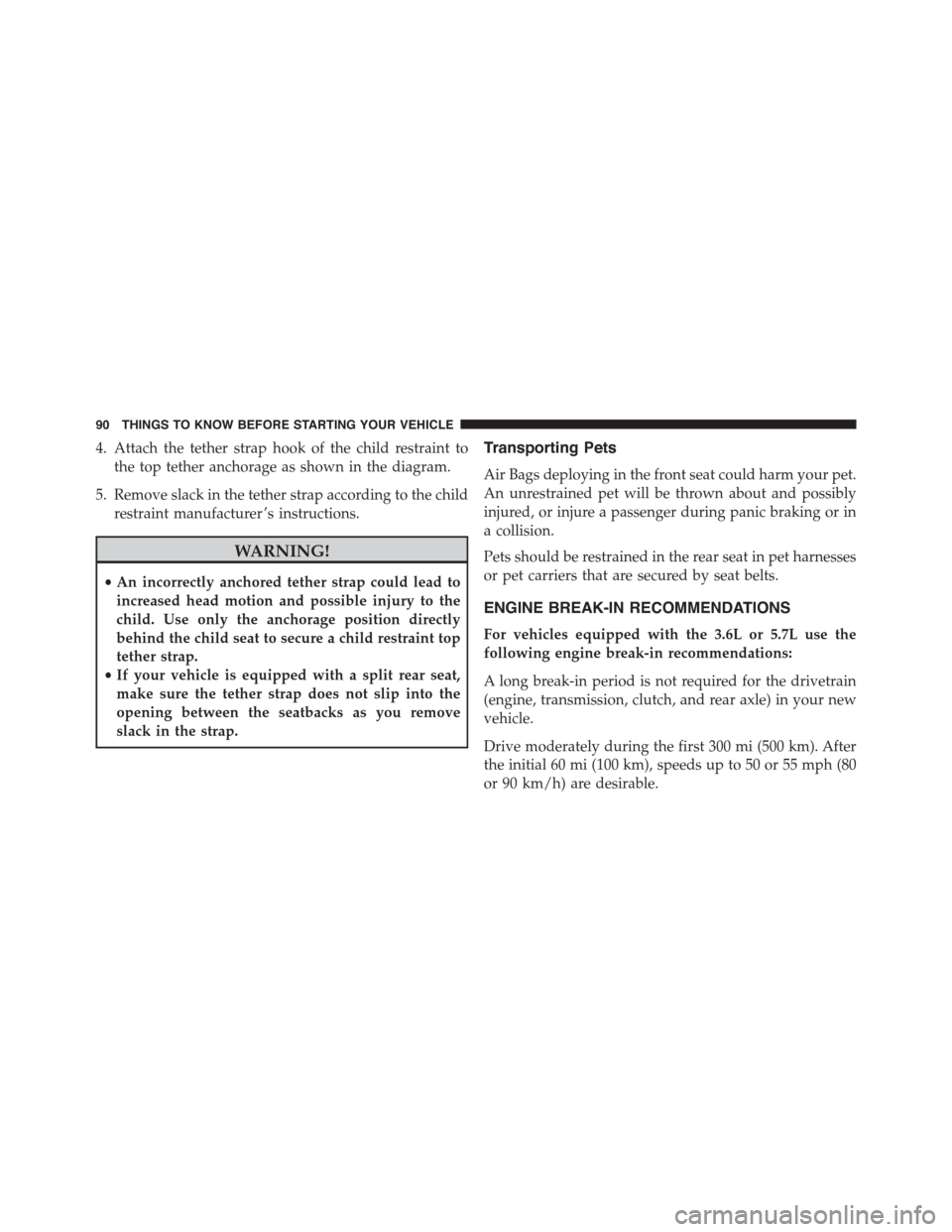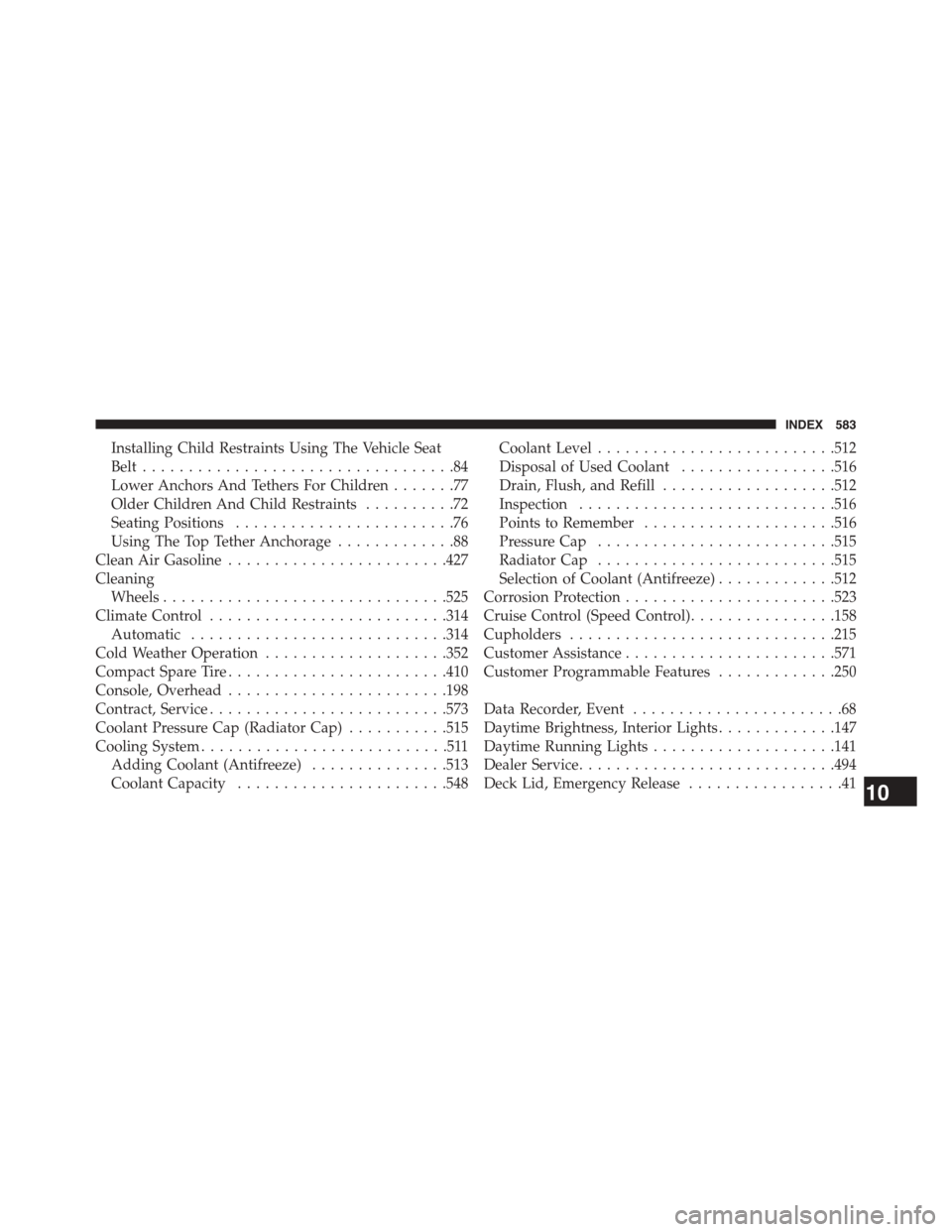Page 91 of 603
3. Route the tether strap to provide the most direct path
for the strap between the anchor and the child seat. If
your vehicle is equipped with adjustable rear head
restraints, raise the head restraint, and where possible,
route the tether strap under the head restraint and
between the two posts. If not possible, lower the head
restraint and pass the tether strap around the outboard
side of the head restraint.
Tether Strap Mounting
1—Cover3 — Attaching StrapA — Tether Strap HookB—TetherAnchor
2
THINGS TO KNOW BEFORE STARTING YOUR VEHICLE 89
Page 92 of 603

4. Attach the tether strap hook of the child restraint to
the top tether anchorage as shown in the diagram.
5. Remove slack in the tether strap according to the child
restraint manufacturer ’s instructions.
WARNING!
•An incorrectly anchored tether strap could lead to
increased head motion and possible injury to the
child. Use only the anchorage position directly
behind the child seat to secure a child restraint top
tether strap.
•If your vehicle is equipped with a split rear seat,
make sure the tether strap does not slip into the
opening between the seatbacks as you remove
slack in the strap.
Transporting Pets
Air Bags deploying in the front seat could harm your pet.
An unrestrained pet will be thrown about and possibly
injured, or injure a passenger during panic braking or in
a collision.
Pets should be restrained in the rear seat in pet harnesses
or pet carriers that are secured by seat belts.
ENGINE BREAK-IN RECOMMENDATIONS
For vehicles equipped with the 3.6L or 5.7L use the
following engine break-in recommendations:
A long break-in period is not required for the drivetrain
(engine, transmission, clutch, and rear axle) in your new
vehicle.
Drive moderately during the first 300 mi (500 km). After
the initial 60 mi (100 km), speeds up to 50 or 55 mph (80
or 90 km/h) are desirable.
90 THINGS TO KNOW BEFORE STARTING YOUR VEHICLE
Page 95 of 603
For the first 1500 mi (2414 km):
•Do not participate in track events, sport driving
schools, or similar activities during the first 1500 mi
(2414 km).
NOTE:Check engine oil with every refueling and add if
necessary. Oil and fuel consumption may be higher
through the first oil change interval.
SAFETY TIPS
Transporting Passengers
NEVER TRANSPORT PASSENGERS IN THE CARGO
AREA.
WARNING!
•Do not leave children or animals inside parked
vehicles in hot weather. Interior heat build-up may
cause serious injury or death.
•It is extremely dangerous to ride in a cargo area,
inside or outside of a vehicle. In a collision, people
riding in these areas are more likely to be seriously
injured or killed.
•Do not allow people to ride in any area of your
vehicle that is not equipped with seats and seat
belts.
•Be sure everyone in your vehicle is in a seat and
using a seat belt properly.
2
THINGS TO KNOW BEFORE STARTING YOUR VEHICLE 93
Page 138 of 603
WARNING!
•Be certain that the seatback is securely locked into
position. If the seatback is not securely locked into
position, the seat will not provide the proper sta-
bility for child seats and/or passengers. An improp-
erly latched seat could cause serious injury.
•The cargo area in the rear of the vehicle (with the
rear seatbacks in the locked-up or folded down
position) should not be used as a play area by
children when the vehicle is in motion. They could
be seriously injured in a collision. Children should
be seated and using the proper restraint system.
TO OPEN AND CLOSE THE HOOD
Two latches must be released to open the hood.
1. Pull the hood release lever located under the left side
of the instrument panel.
2. Move to the outside of the vehicle, the safety catch is
located under the center front edge of the hood.
Hood Release Lever
136 UNDERSTANDING THE FEATURES OF YOUR VEHICLE
Page 210 of 603
POWER SUNROOF — IF EQUIPPED
The power sunroof switch is located between the sun
visors on the overhead console.
WARNING!
•Never leave children unattended in a vehicle, or
with access to an unlocked vehicle. Never leave the
Key Fob in or near the vehicle, or in a location
accessible to children. Do not leave the ignition of
a vehicle equipped with Keyless Enter-N-Go™ in
the ACC or ON/RUN mode. Occupants, particu-
larly unattended children, can become entrapped
by the power sunroof while operating the power
sunroof switch. Such entrapment may result in
serious injury or death.
•In a collision, there is a greater risk of being thrown
from a vehicle with an open sunroof. You could
also be seriously injured or killed. Always fasten
your seat belt properly and make sure all passen-
gers are also properly secured.
(Continued)
Power Sunroof Switch
208 UNDERSTANDING THE FEATURES OF YOUR VEHICLE
Page 349 of 603

STARTING PROCEDURES
Before starting your vehicle, adjust your seat, adjust the
inside and outside mirrors, fasten your seat belt, and if
present, instruct all other occupants to buckle their seat
belts.
WARNING!
•When leaving the vehicle, always remove the Key
Fob from the ignition and lock your vehicle.
•Never leave children alone in a vehicle, or with
access to an unlocked vehicle. Allowing children to
be in a vehicle unattended is dangerous for a
number of reasons. A child or others could be
seriously or fatally injured. Children should be
warned not to touch the parking brake, brake pedal
or the shift lever.
(Continued)
WARNING!(Continued)
•Do not leave the Key Fob in or near the vehicle (or
in a location accessible to children), and do not
leave the ignition of a vehicle equipped with
Keyless Enter-N-Go™ in the ACC or ON/RUN
mode. A child could operate power windows, other
controls, or move the vehicle.
Manual Transmission — If Equipped
Apply the parking brake, place the shift lever in NEU-
TRAL and press the clutch pedal before starting vehicle.
This vehicle is equipped with a clutch interlocking igni-
tion system. It will not start unless the clutch pedal is
pressed to the floor.
Normal Starting With Integrated Key — Manual
Transmission
Normal starting of either a cold or a warm engine does
not require pumping or pressing the accelerator pedal.
5
STARTING AND OPERATING 347
Page 584 of 603

Anti-Lock (ABS)........................382
Fluid Check...........................518
Master Cylinder........................518
Parking..............................377
Warning Light.........................227
Brake/Transmission Interlock.................361
Break-In Recommendations, New Vehicle.........90
Brightness, Interior Lights...................145
Bulb Replacement.........................543
Bulbs, Light..............................97
Camera, Rear............................195
Capacities, Fluid..........................548
Caps, Filler
Fuel.................................431
Oil (Engine)...........................499
Radiator (Coolant Pressure)................515
Carbon Monoxide Warning...................94
Cargo (Vehicle Loading)....................433
Car Washes.............................524
Cellular Phone...........................312
Center High Mounted Stop Light..............547
Certification Label.........................433
Chains, Tire.............................415
Changing A Flat Tire.......................466
Chart, Tire Sizing.........................393
Check Engine Light (Malfunction Indicator Light) . .493
Checking Your Vehicle For Safety...............93
Checks, Safety............................93
Child Restraint............................69
Child Restraints
Booster Seats...........................74
Center Seat LATCH......................82
Child Restraints.........................69
Child Seat Installation.....................87
How To Stow An Unused ALR Seat Belt........83
Infants And Child Restraints................72
Install A LATCH-compatible Child Restraint.....82
582 INDEX
Page 585 of 603

Installing Child Restraints Using The Vehicle Seat
Belt..................................84
Lower Anchors And Tethers For Children.......77
Older Children And Child Restraints..........72
Seating Positions........................76
Using The Top Tether Anchorage.............88
Clean Air Gasoline........................427
Cleaning
Wheels...............................525
Climate Control..........................314
Automatic............................314
Cold Weather Operation....................352
Compact Spare Tire........................410
Console, Overhead........................198
Contract, Service..........................573
Coolant Pressure Cap (Radiator Cap)...........515
Cooling System...........................511
Adding Coolant (Antifreeze)...............513
Coolant Capacity.......................548
Coolant Level..........................512
Disposal of Used Coolant.................516
Drain, Flush, and Refill...................512
Inspection............................516
Points to Remember.....................516
Pressure Cap..........................515
Radiator Cap..........................515
Selection of Coolant (Antifreeze).............512
Corrosion Protection.......................523
Cruise Control (Speed Control)................158
Cupholders.............................215
Customer Assistance.......................571
Customer Programmable Features.............250
Data Recorder, Event.......................68
Daytime Brightness, Interior Lights.............147
Daytime Running Lights....................141
Dealer Service............................494
Deck Lid, Emergency Release.................4110
INDEX 583